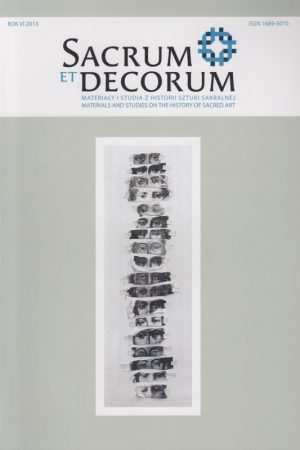Stained-glass windows of the Kashubian Calvary in Wiele
Keywords:
Calvary, Wiele, stained-glass window, Roger Sławski, Theodor Mayr, Gebhard Fügel, Theodor Baierl, Franz Zettler, Hans BockhorniAbstract
The stained-glass windows of the Calvary in Wiele in Kashubia from 1915–1922 constitute important decorative and conceptual elements of a large landscape architecture project. The construction of the complex started by rector Józef Szydzik during the Partition of Poland was continued when Poland regained independence by his successor priest Józef Wrycz. The direct ideological motivation for the erection of the Calvary was the desire to commemorate the sacrifices of the local community on the front line of World War I and to manifest the Polish religious spirit of the Kashubians. The complex includes altogether 14 chapels, 7 carving compositions, “Scalae Sanctae” and a hermitage, which makes it possible to classify it as one of the so-called great Calvaries. The author of the project of the establishment was Theodor Mayr, an architect from Munich. The complex is stylistically consistent with the modernist interpretation of Baroque forms with a tendency use them freely. At the same time, it is not deprived of references to the elements of the regional Kashubian architectural style. The earliest five buildings were fitted with stained-glass windows manufactured in renown Munich workshops of Franz Xavier Zettler and Hans Bockhorni to designs by Bavarian artists Gebhard Fügel and Theodor Baierl. The most important decorative elements of the interior of the main chapel of Crucifixion are three impressive stained-glass windows designed by Theodor Baierl from 1916. In terms of the message they convey, these stained-glass windows serve as a medium of religious symbolism, but they also make reference to contemporary events and preserve images of the of local people in a specific situational context. During World War II, on the initiative of occupational authorities, who incorporated the Calvary into the German cultural heritage, the renovation of the chapels was carried out. After the war, the buildings gradually deteriorated, and some of the stained-glass windows were completely destroyed. It was only in 2001 that three figurative stained-glass windows of the chapel of the Crucifixion underwent thorough renovation in the workshop of Władysław and Wojciech Kozioł in Toruń.Downloads
Downloads
Published
How to Cite
Issue
Section
License
Copyright (c) 2013 Sacrum et Decorum

This work is licensed under a Creative Commons Attribution-NonCommercial-NoDerivatives 4.0 International License.
In line with the Open Access policy, authors retain full copyright to their articles – without restrictions.
Authors can deposit their articles in a repository of their choice.


